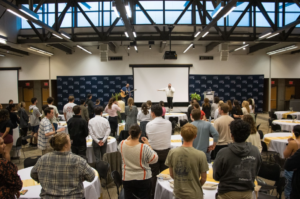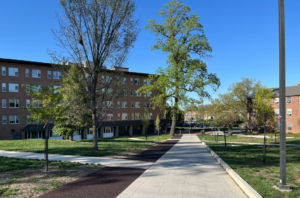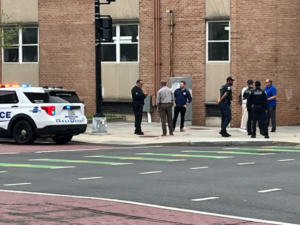Construction on Campus
By Paige Wearmouth
Beginning late in the spring semester and continuing throughout the summer, several buildings and outdoor areas of the University’s campus underwent construction.
A large portion of the summer improvements took place in Centennial Village. Fresh landscaping, re-paved sidewalks and entrance ways, and a new fountain were installed within the village circle. In addition, the lawn area in the center was transformed into a brand new basketball court.
According to Victor Nakas, these enhancements were not solely cosmetic. They provide a place for recreation and general campus community usage, as well as serving a very functional purpose.
“It was also designed to reduce stormwater runoff, thus reducing storm water surcharges the University has to pay to the District of Columbia. It is a green space with native plantings that require less water,” Nakas said.
While these renovations improve the aesthetic appeal of the hub of residence life, they leave some students concerned about how the University is handling the allocation of funds.
“I understand the benefits of the renovations, but I do not feel they were necessary. After making so many budget cuts and reducing the staff last semester, I can’t understand why they would spend money on landscape,” said an anonymous student.
Furthermore, the University’s 2012 Master Plan placed the dormitory halls of Centennial Village on a list of buildings to be demolished. For some students, this information appears conflicting. They wonder why the school would spend money on an area that will eventually be torn down and repurposed.
Junior nursing major Rania Abousleiman reported that while she does appreciate the immediate improvements made in Centennial Village, she does not find them to be prudent in light of the Master Plan.
“I think the school should spend money on building repairs instead of just building new ones,” Abousleiman said.
While many relatively new buildings are listed as “Buildings to be Demolished” in the Master Plan, several older buildings are protected by their historic value.
This list includes Caldwell, McMahon, and Marist Halls. Other notable historic buildings, Father O’Connell, Gibbons, and Maloney, have each recently undergone renovation.
Earlier in 2015, Father O’Connell Hall was reopened as the new campus Admissions Office following extensive interior reconstruction. Over the course of spring and summer, the lobby of Gibbons Hall was refurbished.
Maloney Hall, which is almost one hundred years old, was closed in 2014 due to issues making it unfit for students, faculty, and staff. It remains closed and no further details regarding a renovation schedule for this building have been released.
“Maloney Hall is being decommissioned and stabilized. This will be an on-going process as it is a 100-year-old structure,” commented Victor Nakas.
Other construction improvements made over the summer break include enhancements to the Caldwell and Seton Hall restrooms as well as the addition of a new press box in the DuFour center. A PDF of the Master Plan for the Catholic University improvements is accessible online at masterplan.cua.edu








